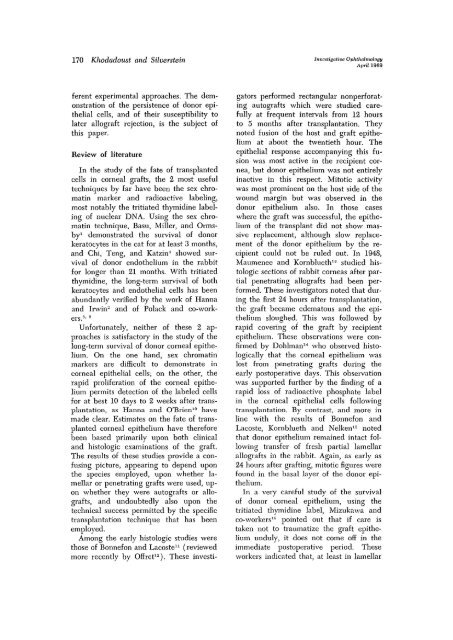The survival and rejection of epithelium in experimental corneal ...
The survival and rejection of epithelium in experimental corneal ...
The survival and rejection of epithelium in experimental corneal ...
Create successful ePaper yourself
Turn your PDF publications into a flip-book with our unique Google optimized e-Paper software.
170 Khodadoust <strong>and</strong> Silverste<strong>in</strong> Investigative Ophthalmology<br />
April 1969<br />
ferent <strong>experimental</strong> approaches. <strong>The</strong> demonstration<br />
<strong>of</strong> the persistence <strong>of</strong> donor epithelial<br />
cells, <strong>and</strong> <strong>of</strong> their susceptibility to<br />
later allograft <strong>rejection</strong>, is the subject <strong>of</strong><br />
this paper.<br />
Review <strong>of</strong> literature<br />
In the study <strong>of</strong> the fate <strong>of</strong> transplanted<br />
cells <strong>in</strong> <strong>corneal</strong> grafts, the 2 most useful<br />
techniques by far have been the sex chromat<strong>in</strong><br />
marker <strong>and</strong> radioactive label<strong>in</strong>g,<br />
most notably the tritiated thymid<strong>in</strong>e label<strong>in</strong>g<br />
<strong>of</strong> nuclear DNA. Us<strong>in</strong>g the sex chromat<strong>in</strong><br />
technique, Basu, Miller, <strong>and</strong> Ormsby<br />
1 demonstrated the <strong>survival</strong> <strong>of</strong> donor<br />
keratocytes <strong>in</strong> the cat for at least 3 months,<br />
<strong>and</strong> Chi, Teng, <strong>and</strong> Katz<strong>in</strong> 4 showed <strong>survival</strong><br />
<strong>of</strong> donor endothelium <strong>in</strong> the rabbit<br />
for longer than 21 months. With tritiated<br />
thymid<strong>in</strong>e, the long-term <strong>survival</strong> <strong>of</strong> both<br />
keratocytes <strong>and</strong> endothelial cells has been<br />
abundantly verified by the work <strong>of</strong> Harm a<br />
<strong>and</strong> Irvv<strong>in</strong>- <strong>and</strong> <strong>of</strong> Polack <strong>and</strong> co-workers.<br />
3 ' °<br />
Unfortunately, neither <strong>of</strong> these 2 approaches<br />
is satisfactory <strong>in</strong> the study <strong>of</strong> the<br />
long-term <strong>survival</strong> <strong>of</strong> donor <strong>corneal</strong> <strong>epithelium</strong>.<br />
On the one h<strong>and</strong>, sex chromat<strong>in</strong><br />
markers are difficult to demonstrate <strong>in</strong><br />
<strong>corneal</strong> epithelial cells; on the other, the<br />
rapid proliferation <strong>of</strong> the <strong>corneal</strong> <strong>epithelium</strong><br />
permits detection <strong>of</strong> the labeled cells<br />
for at best 10 days to 2 weeks after transplantation,<br />
as Hanna <strong>and</strong> O'Brien 10 have<br />
made clear. Estimates on the fate <strong>of</strong> transplanted<br />
<strong>corneal</strong> <strong>epithelium</strong> have therefore<br />
been based primarily upon both cl<strong>in</strong>ical<br />
<strong>and</strong> histologic exam<strong>in</strong>ations <strong>of</strong> the graft.<br />
<strong>The</strong> results <strong>of</strong> these studies provide a confus<strong>in</strong>g<br />
picture, appear<strong>in</strong>g to depend upon<br />
the species employed, upon whether lamellar<br />
or penetrat<strong>in</strong>g grafts were used, upon<br />
whether they were autografts or allografts,<br />
<strong>and</strong> undoubtedly also upon the<br />
technical success permitted by the specific<br />
transplantation technique that has been<br />
employed.<br />
Among the early histologic studies were<br />
those <strong>of</strong> Bonnefon <strong>and</strong> Lacoste 11 (reviewed<br />
more recently by Offret 12 ). <strong>The</strong>se <strong>in</strong>vestigators<br />
performed rectangular nonperforat<strong>in</strong>g<br />
autografts which were studied carefully<br />
at frequent <strong>in</strong>tervals from 12 hours<br />
to 5 months after transplantation. <strong>The</strong>y<br />
noted fusion <strong>of</strong> the host <strong>and</strong> graft <strong>epithelium</strong><br />
at about the twentieth hour. <strong>The</strong><br />
epithelial response accompany<strong>in</strong>g this fusion<br />
was most active <strong>in</strong> the recipient cornea,<br />
but donor <strong>epithelium</strong> was not entirely<br />
<strong>in</strong>active <strong>in</strong> this respect. Mitotic activity<br />
was most prom<strong>in</strong>ent on the host side <strong>of</strong> the<br />
wound marg<strong>in</strong> but was observed <strong>in</strong> the<br />
donor <strong>epithelium</strong> also. In those cases<br />
where the graft was successful, the <strong>epithelium</strong><br />
<strong>of</strong> the transplant did not show massive<br />
replacement, although slow replacement<br />
<strong>of</strong> the donor <strong>epithelium</strong> by the recipient<br />
could not be ruled out. In 1948,<br />
Maumenee <strong>and</strong> Kornblueth 13 studied histologic<br />
sections <strong>of</strong> rabbit corneas after partial<br />
penetrat<strong>in</strong>g allografts had been performed.<br />
<strong>The</strong>se <strong>in</strong>vestigators noted that dur<strong>in</strong>g<br />
the first 24 hours after transplantation,<br />
the graft became edematous <strong>and</strong> the <strong>epithelium</strong><br />
sloughed. This was followed by<br />
rapid cover<strong>in</strong>g <strong>of</strong> the graft by recipient<br />
<strong>epithelium</strong>. <strong>The</strong>se observations were confirmed<br />
by Dohlman 14 who observed histologically<br />
that the <strong>corneal</strong> <strong>epithelium</strong> was<br />
lost from penetrat<strong>in</strong>g grafts dur<strong>in</strong>g the<br />
early postoperative days. This observation<br />
was supported further by the f<strong>in</strong>d<strong>in</strong>g <strong>of</strong> a<br />
rapid loss <strong>of</strong> radioactive phosphate label<br />
<strong>in</strong> the <strong>corneal</strong> epithelial cells follow<strong>in</strong>g<br />
transplantation. By contrast, <strong>and</strong> more <strong>in</strong><br />
l<strong>in</strong>e with the results <strong>of</strong> Bonnefon <strong>and</strong><br />
Lacoste, Kornblueth <strong>and</strong> Nelken 15 noted<br />
that donor <strong>epithelium</strong> rema<strong>in</strong>ed <strong>in</strong>tact follow<strong>in</strong>g<br />
transfer <strong>of</strong> fresh partial lamellar<br />
allografts <strong>in</strong> the rabbit. Aga<strong>in</strong>, as early as<br />
24 hours after graft<strong>in</strong>g, mitotic figures were<br />
found <strong>in</strong> the basal layer <strong>of</strong> the donor <strong>epithelium</strong>.<br />
In a very careful study <strong>of</strong> the <strong>survival</strong><br />
<strong>of</strong> donor <strong>corneal</strong> <strong>epithelium</strong>, us<strong>in</strong>g the<br />
tritiated thymid<strong>in</strong>e label, Mizukawa <strong>and</strong><br />
co-workers 10 po<strong>in</strong>ted out that if care is<br />
taken not to traumatize the graft <strong>epithelium</strong><br />
unduly, it does not come <strong>of</strong>f <strong>in</strong> the<br />
immediate postoperative period. <strong>The</strong>se<br />
workers <strong>in</strong>dicated that, at least <strong>in</strong> lamellar
















